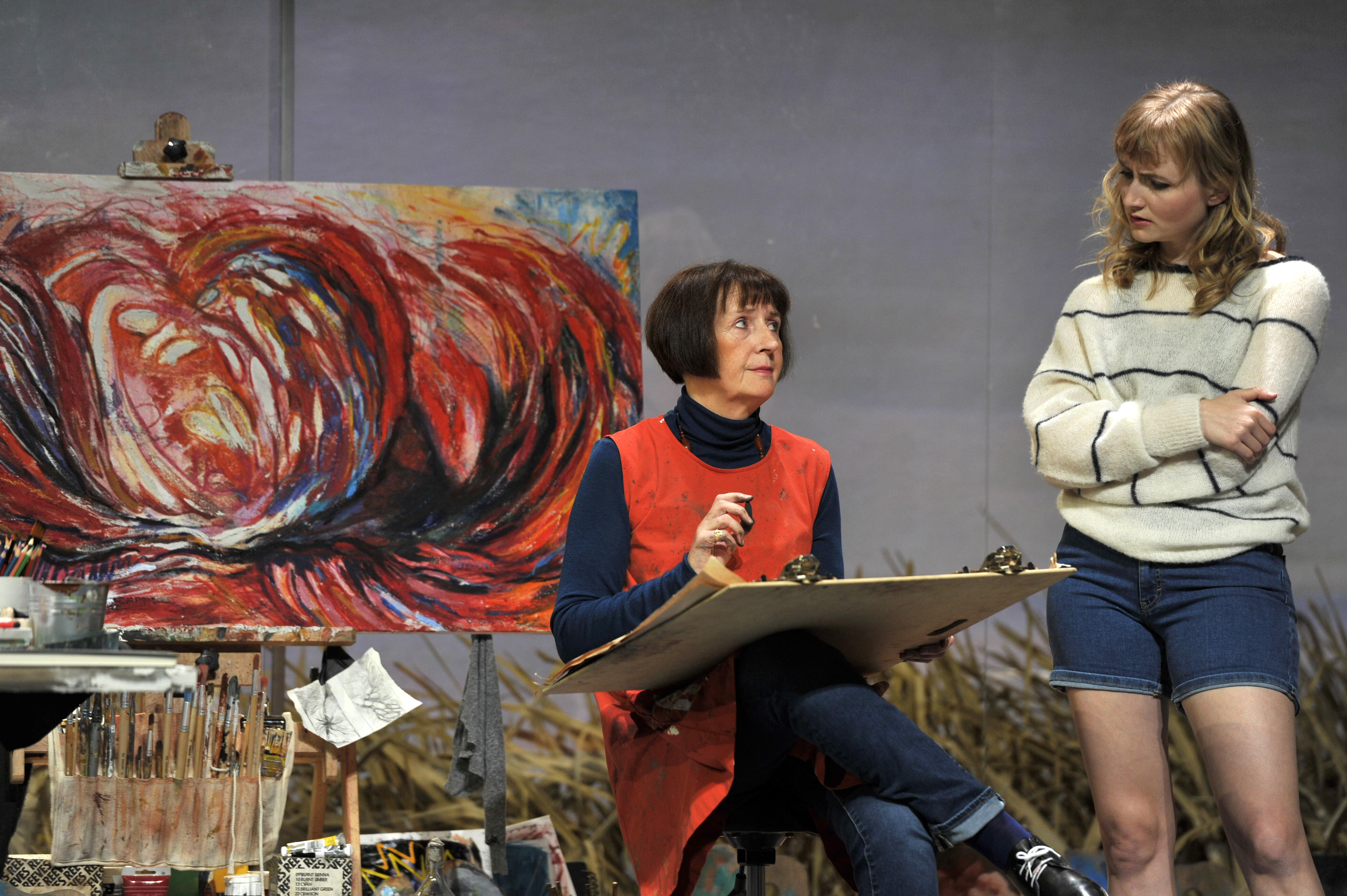Upon first look at Francis O’Connor’s set gracing the stage of the Gate Theatre, I immediately understood what I’d just read in the program seconds before: that this mise-en-scène is in its own right a “play”. The sitting room is bare apart from some art materials, minimalist furniture and a striking painting by O’Connor himself. The room is surrounded by glass walls, overlooking a picturesque and ominously calm West Cork seascape, reflecting a satisfying unity of place, setting and subject — we, the audience, are looking into this “glass box”, invited by its very existence.
The set is itself a telling and dynamic character — the painting glows in part and in full depending on the moment, the sky behind the characters fades accordingly, and the sea is constant, the characters cannot escape it nor what it represents. The painting, backlit and demanding of attention, bears lashes of vibrant colours resembling a blood-red sea during a storm. The beginning of the show sees the comic relief Bonnie (Rae Gray) proclaim what she sees in the painting: female suffering, menstrual blood, and abortion. Of course, Colm (Marty Rea) reminds her, as an art history drop-out, she would know. Beiv (Jane Brennan) then crushes her spirit with one fell swoop: “It’s a blood orange.” This humour contributes to the gratifying circularity of the work. The beginning sees Bonnie bestowing meaning onto something Beiv claims to be literal, shying away from the vulnerability she put into it; whereas the end sees a character having a reluctantly cathartic moment of their own in response to the painting, one the audience has been made desperate for.
The querulous and deeply unlikeable character of Colm becomes almost a parody of a privileged son, constantly defending his choice to become a software engineer rather than an artist like his mother, Beiv. The matriarch is a queer artist infamous for rumours of killing her husband, living off his money, and starting an all-female artist colony with whispers of “orgies” and other kinds of debauchery found unsavoury by the locals. A structural conceit exists in the idea of inheritance, expression versus repression, and this pervades the internal and external realities of the play. Colm has clearly inherited some of Beiv’s defining characteristics, while rejecting those traits in himself and denigrating her for her self-acceptance. He lives in the delusion that he is like his father, inherently “kind” and practical, only succumbing to his demons when he’s back in that house, back with his mother. Donal provides a refreshing sense of stability — opening each character up with kindness, honesty and loyalty, and illustrating how these traits can enact growth.
Donal, convincingly played by Ian-Lloyd Anderson, is a welcome relief from Marty Rea’s veer toward over-acting, including an accent slipping from Sandymount back to Belfast by the end of the show. Jane Brennan’s Beiv is natural to her — unfaltering as well as both terrifying and mesmerising. The cottage itself is its own “beacon”, a warning sign to observers that Beiv has nothing to hide and her reputation won’t lead her presence to be minimised or reduced, only amplified. The subplot involving a podcast centred around the father’s death injects humour into tense moments, with scene transition music which is reminiscent of any true-crime podcast’s theme song.
The curious stock-type mystery plot only serves to emphasise the real triumphs of the play — the psychological revelations, relationship dynamics, and truth superseding denial, ignorance, or shame. Virginia Woolf’s desire to “strain off what was personal and accidental … and so reach the pure fluid, the essential oil of truth” in her writing resonates with Jane’s artistic endeavours — a blood orange becomes something much bigger than the personal or the accidental, and it dialogues with each character from beginning to end. The painting, anchored on stage, is a tangible reminder that regardless of whether or not one “believes” in abstract art, it works independently and contains its own truths tailored to each individual interpreter. In the program, Harris deems ponderings like this to be key sources of inspiration: “… are there some artists for whom there is no separation between their art and their life? And if so, when it comes to the darkest of life’s secrets, where does one draw the line between art and life?”
Harris skilfully navigates self-disclosure so that it is at once natural and nuanced; each theatrical element and narrative thread work in harmony, the deft acting further draws you into their world, and the overall effect is stunning. The way Harris refuses to neglect storytelling for set-up, exposition for character evolution, and humour for pathos is what cements The Beacon as a testament to the quality of Irish drama today.
Written by Nancy Harris and directed by Garry Hynes, The Beacon runs in the Gate Theatre from 3-12 October as part of the Dublin Theatre Festival.






